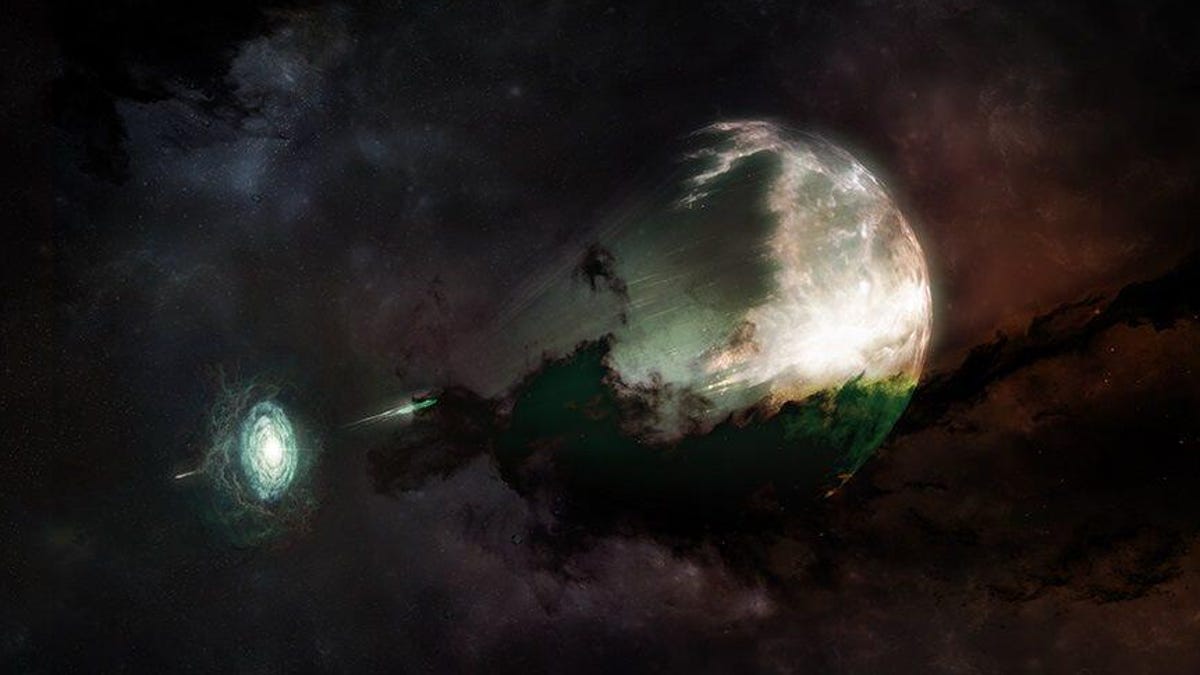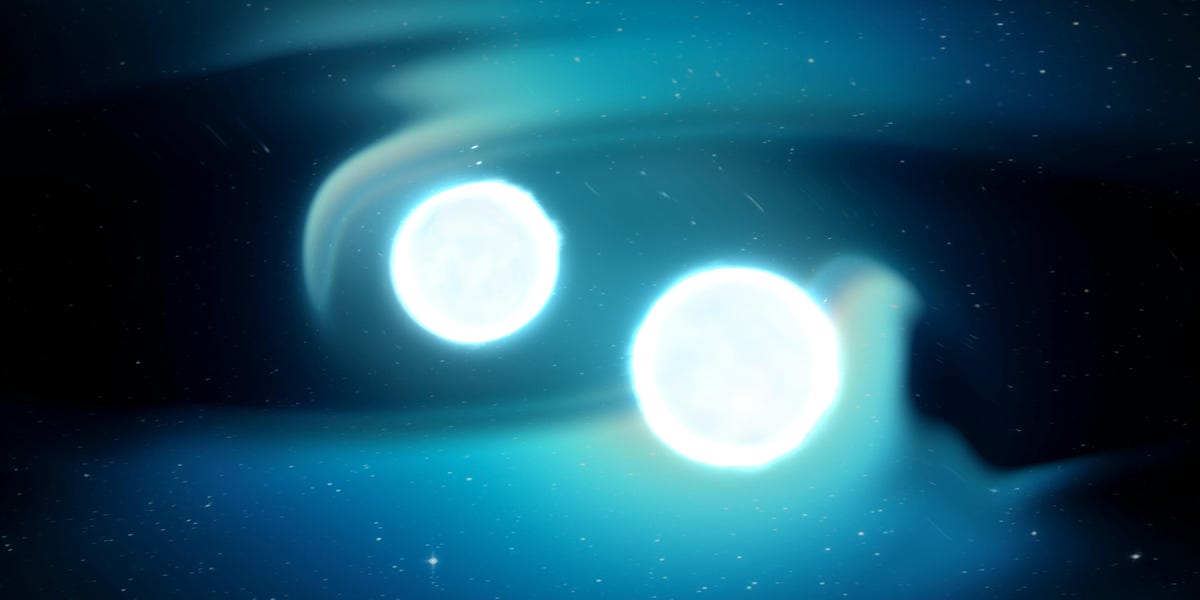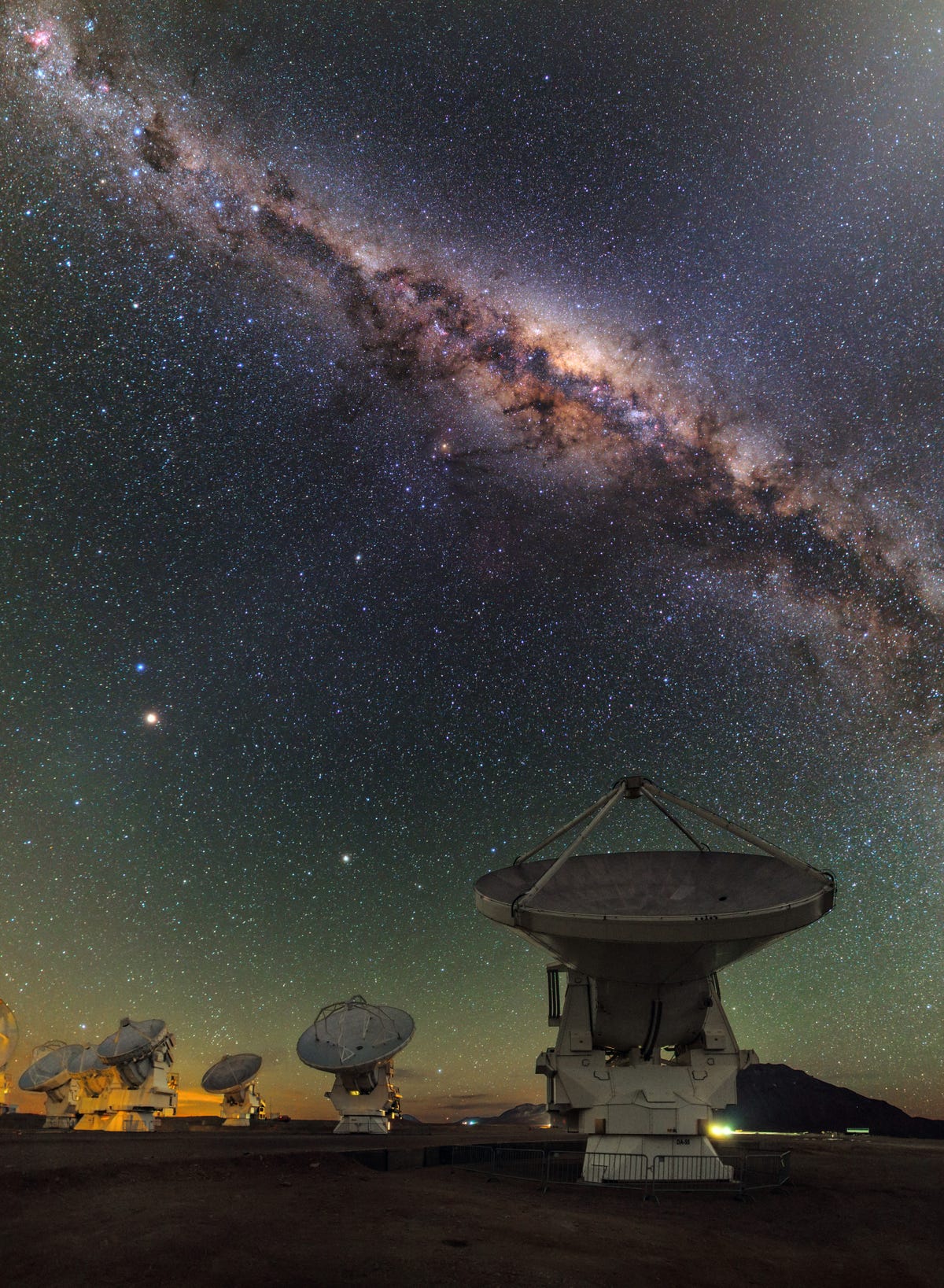
Posted on 08/05/2022 6:25:10 AM PDT by Red Badger
An illustration depicting GRB21106A. The event itself is seen as a white jet in the center of the frame, stemming from the merger seen as a pale blue lighted disk on the bottom left, and the shockwave afterglow is seen as a larger, semi-circular lit-up region toward the middle right.

This artist's conception shows the merger between a neutron star and another star (disk, lower left) which caused an explosion resulting in GRB 211106A (white jet, middle), and left behind one of the most luminous afterglows on record (semispherical shock wave midright). ALMA (ESO/NAOJ/NRAO), M. Weiss (NRAO/AUI/NSF)
**************************************************************************************
Astronomers presented us with a mysterious video Wednesday: footage decked with lime green smudges steadily evolving on a dark background. But right at the center of this recording, one smudge isn't like the others. It's the brightest neon blob of all, and it enhances with each frame.
What you're seeing is proof that some 20 billion years ago an ultrapowerful neutron star collided with a weaker star, spitting out an explosive, short-lived gamma ray burst, rippling gravitational waves across the cosmos and diffusing surrounding space with a potent afterglow. It was a shattering merger that occurred when the universe was at just 40% its current age, and our remarkable view of its incident is courtesy of the world's largest radio telescope, the Atacama Large Millimeter/submillimeter Array situated in Chile.
More specifically, ALMA is a combination of 66 radio telescopes spread out across the high-altitude Chilean Andes. And they work together to bring us data about our universe's violent side.
"Afterglows for short bursts are very difficult to come by, so it was spectacular to catch this event shining so brightly," Wen-fai Fong, an astronomer at Northwestern University and principal investigator of the ALMA program, said in a statement. "This surprising discovery opens up a new area of study, as it motivates us to observe many more of these with ALMA and other telescope arrays in the future."
VIDEO AT LINK.........................
The first-ever time-lapse footage of a short gamma ray burst's afterglow captured in millimeter wavelengths by ALMA
ALMA (ESO/NAOJ/NRAO), T. Laskar (Utah), S. Dagnello (NRAO/AUI/NSF) Details of Fong and fellow researchers' findings are soon to be published in an upcoming issue of The Astrophysical Journal Letters. For now, a preprint is available to view on arXiv.
An incomprehensible force of nature Short-lived gamma ray bursts, like this one formally dubbed GRB 211106A, are some of the most intense, mind-bendingly strong explosions known to science. But in contrast to longer-lived ones, they remained a mystery due to their fleeting nature, until 2005, when NASA's Neil Gehrels Swift Observatory collected data about one for the first time.
In a matter of seconds, these cosmic spurts can emit more energy than our sun will emit in its entire lifetime. Though such extremity makes sense for them, because these phenomena stem from binary star collisions that involve at least one neutron star, a hyperdense ball of gas that rivals even black holes in gravitational monstrosity.
Just one tablespoon of a neutron star would equal something like the weight of Mount Everest.

neutron-star-merger-still-12
A still of two neutron stars about to merge. Replace one with a normal star and you might be imagining what happened long ago with the cosmic subjects of this new study.
NASA's Goddard Space Flight Center/CI Lab
************************************************************************
"These mergers occur because of gravitational wave radiation that removes energy from the orbit of the binary stars, causing the stars to spiral in toward each other," Tanmoy Laskar, lead author of the study and an astronomer at Radboud University, said in a statement. "The resulting explosion is accompanied by jets moving at close to the speed of light. When one of these jets is pointed at Earth, we observe a short pulse of gamma-ray radiation or a short-duration GRB."
That's the vivid green blip we see in the recent burst's recording.
ALMA's expertise
The fact that the study team used ALMA to locate this particular burst marks the very first time such an event has been captured in millimeter wavelengths, the Chilean 'scope's specialty.
Although this dramatic collision had already been studied with NASA's Hubble Space Telescope, it was seen only under the guise of optical and infrared light wavelengths. With those wavelengths, Hubble could basically only estimate information about the faraway galaxy this merger happened within, but not too much about afterglow that followed. Even if the agency's groundbreaking James Webb Space Telescope one day embarks on a mission to investigate GRB 21106A, it'll be restricted to infrared light wavelengths too, though on a much wider spectrum.
ALMA, on the other hand, could see something different than what Hubble did with its millimeter wavelengths -- it indeed captured GRB 21106A's afterglow. And after some deliberation, the new study's team recognized that this short gamma ray burst's afterglow is among the most luminescent ever seen.

ann14045a
This view shows several of the ALMA antennas and central regions of the Milky Way above.
ESO/B. Tafreshi
******************************************************************************************
"What makes GRB 211106A so special is it's not only the first short-duration GRB that we detected in this wavelength, but also, thanks to the millimeter and radio detection, we could measure the opening angle of the jet," Rouco Escorial, study co-author and an astronomer at Northwestern University, said in a statement.
Down the line, such information could prove essential to inferring rates of such GRBs in our universe and comparing them with the rates of double neutron star mergers and perhaps even black hole mergers.
"ALMA shatters the playing field in terms of its capabilities at millimeter wavelengths and has enabled us to see the faint, dynamic universe in this type of light for the first time," Fong said. "After a decade of observing short GRBs, it is truly amazing to witness the power of using these new technologies to unwrap surprise gifts from the universe."
PING!......................
“These phenomena occur due to binary star collisions” Indeed!
Non-Binary stars need not apply........................
Thanks. Very interesting! However, the article says “What you’re seeing is proof that some 20 billion years ago . . .”
I thought the universe was supposed to be about 14 billion years old.
If the age of the universe in approximately 13.7 billion years the 20 billion years figure is wrong. If the merger occurred when the universe was at just 40% its current age that works out to about 8.2 billion years ago. Not sure how the author worked the math. And, of course, that is assuming we have pegged the age of the universe correctly at 13.7 billion years...
It’s hard enough to imagine even One Billion years, let alone 14 or 20.
I suppose we’ll need to trust the science. Not as obvious as rings on a tree. I have to think such speculation is just that, an educated guess based on presumption.
But Monisha says they have the receipts.
I guess that means they have 30 days to return it for a more accurate one.
Just...dayum!
I think the 14.8 billion year estimate is based on the fact that 14.8 bil is as far as we can currently see with current technology. Our universe could be considerably older.
“have the receipts” is one of those faddish phrases I was sick of hearing by about the the third time I saw it used.
Thanks Red Badger.
the rest of the "neutron star" keyword, sorted:
Exactly....something doesn’t add up, or they need an editor.
20 billion years ago? Probably 20 billion light years... although it's not unlikely that the nitwit who wrote the article is another left wing success story.
The size and age of the universe seem to not agree with one another. Astronomers have determined that the universe is nearly 14 billion years old and yet its diameter is 92 billion light years across. How can both of those numbers possibly be true? In this video, Fermilab’s Dr. Don Lincoln tells you how.If the universe is only 14 billion years old,
how can it be 92 billion light years wide?
June 19, 2019 | Fermilab
the press release:
I have to agree with you on the age of the universe. Not having been there at the beginning, and not being good at math, well, I’ll just have to let wiser minds prevail.
‘Face
;o]
I don’t agree with myself, why should you? ;^)
Yes, exactly.
It’s my yob, man!
As a sidebar, I’ve noticed a distinct lack of press releases from the world’s smallest radio telescope, what gives with that I often ask myself...
Disclaimer: Opinions posted on Free Republic are those of the individual posters and do not necessarily represent the opinion of Free Republic or its management. All materials posted herein are protected by copyright law and the exemption for fair use of copyrighted works.